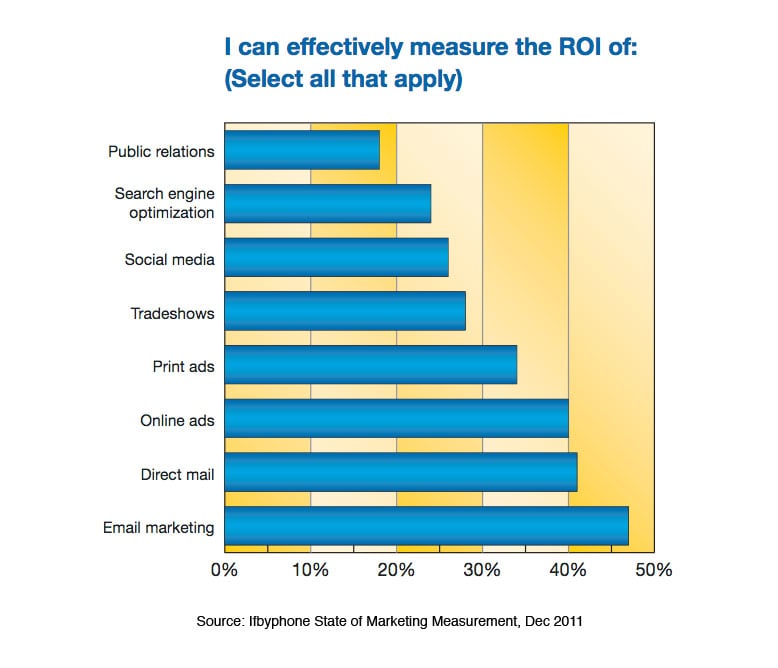
Now that we talked about price, let’s take a look at the kind of return you can expect to see from a digital marketing campaign.
The truth is, most marketers don’t know how to measure their marketing ROI.
According to Marketing Profs, 82% of marketing executives say that they expect campaigns to be measured. And yet only 18% can measure the ROI of public relations, 24% can measure the ROI of search engine optimization, and 26% can measure the ROI of social media.

Source: Ifbyphone Current State of Marketing Measurement 2011 Report
.
There are certain benchmarks for ROI numbers for various channels that are important to remember. Here’s the average return on investment for the following marketing channels for every $1 spent:
| $38 | |
| Search | $22 |
| Internet display advertising | $20 |
| Social media | $13 |
| Mobile | $11 |
| Catalogs | $7 |
Getting a high return depends on a variety of things, which is why no specific result can be guaranteed for any individual company. For example, it could depend on:
- Quality and how competitive the product is in the market
- How competitive and sophisticated the industry is as a whole
- Competence of the agency that’s responsible for marketing the product
- The marketing channel(s) that are being used
- How accurately conversions can be tracked
You should make sure that your agency understands how to calculate ROI. If they don’t, that should be an immediate deal-breaker.
For example, here’s a general way to calculate ROI from an SEO campaign:
Anticipated ROI = (Anticipated Revenue from SEO efforts – Proposed Cost of SEO Project)/Proposed cost of the SEO project
Here’s an example of how to calculate this from Optimize Smart.
Let’s say you run an e-commerce site. Your ROI can be calculated based on average monthly visits to your site, average conversion rate of the site, and average order value.
For example, suppose your average monthly visits is 50,000, your conversion rate is 0.68%, and your average order value is $176. And your agency tells you that you might have to spend $20,000 for your SEO project.
From there, you can determine your “break even” point. This is the point at which you will generate a positive ROI from your agency. This can be determined by:
Proposed cost of project / Average order value
If your proposed cost of project is $20,000 and your average order value is $176, then your break even point is 114 sales.
You can also determine the additional traffic you’ll need to break even. This can be determined by:
Number of orders needed to break even / E-commerce conversion rate
If you need 114 orders to break even, and your conversion rate is 0.68%, then you need 16,765 visits to your site to break even.
Of course, this is just a break even rate. To see significant ROI from the campaign, you’d probably like to see at least double those results as a client. So your ideal number of visits should be over 32,000.
This is just one example of how to calculate expected ROI for a marketing campaign, so you know exactly what results to expect from your marketing agency.
